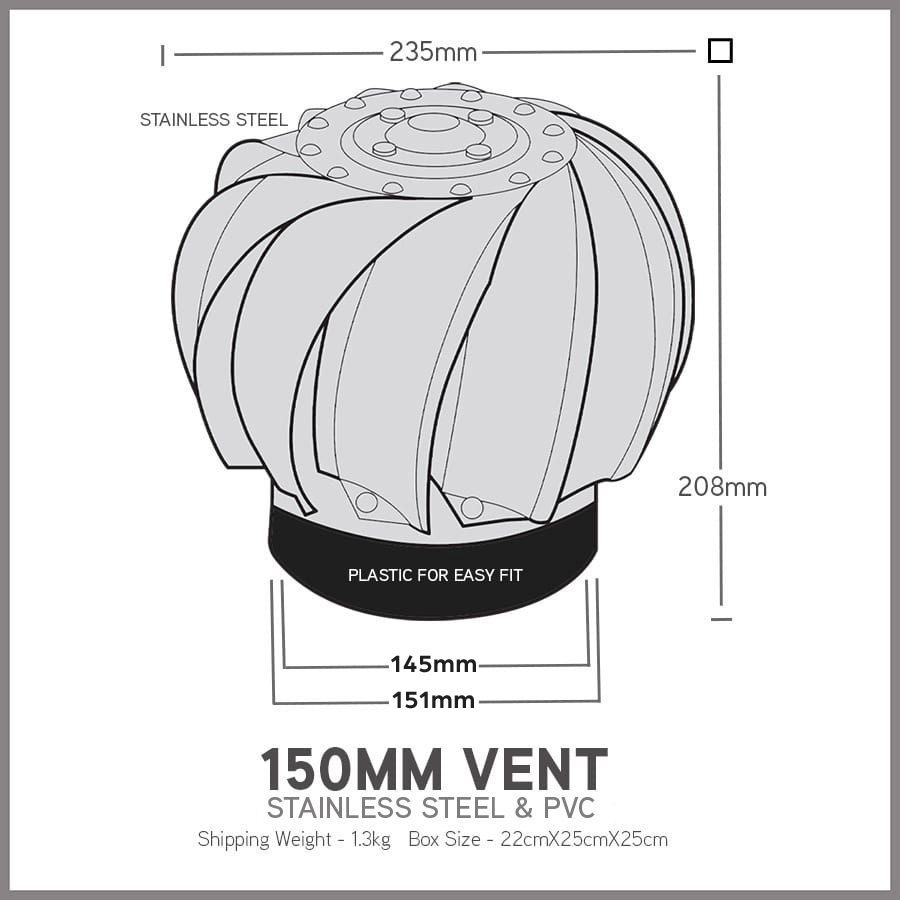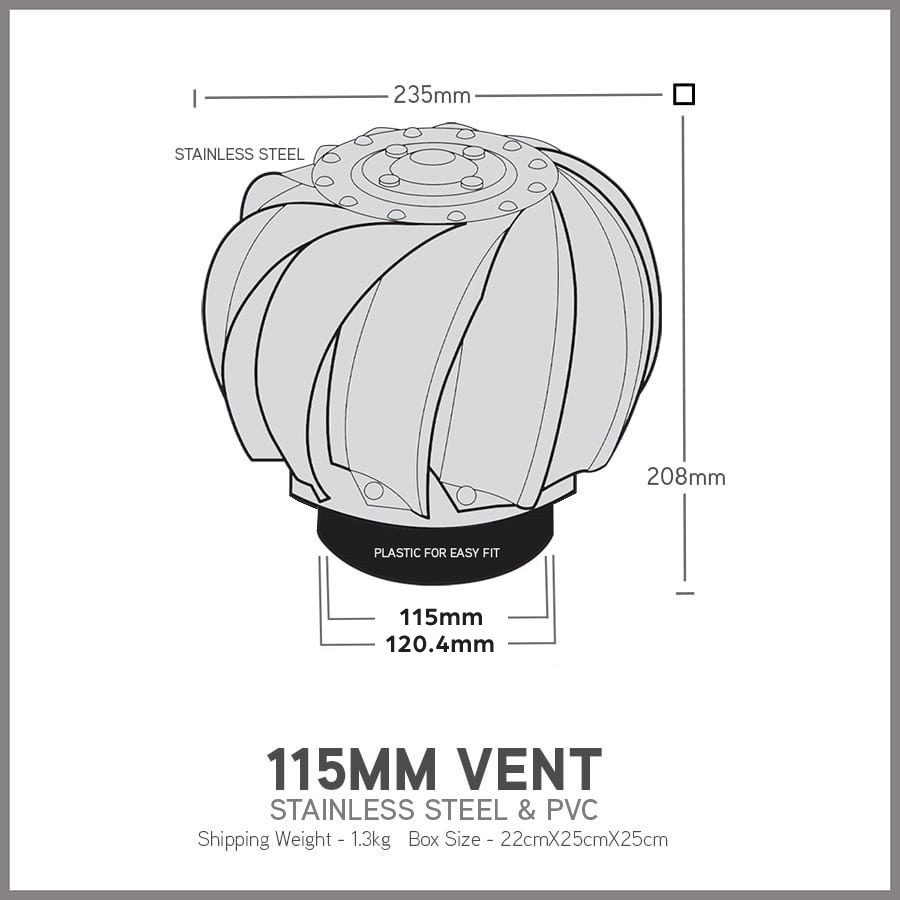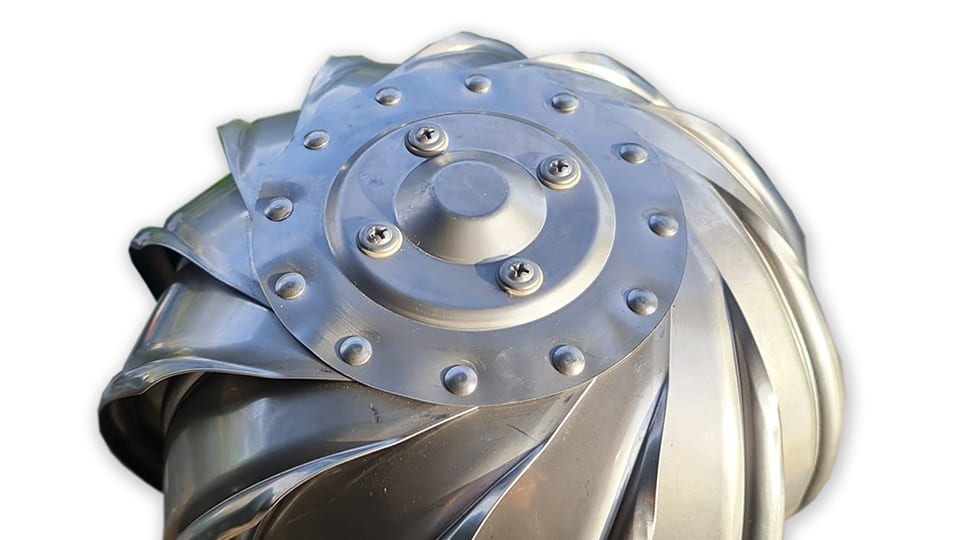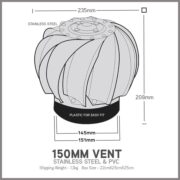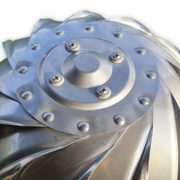Stainless Steel Mini Vents X 12 + Free Delivery (Includes GST)
Price range: $1,125.00 through $1,255.00 & Free Shipping
Having issues ordering? Use our order form
Stainless Steel 150mm & 115mm
By the Box Works Out to be:
$93.75 each (115mm) $104.60 each (150mm)
Free Delivery (Includes GST)
Description
BOX OF 12 + Free Delivery (Includes GST)
By the Box Works Out to be:
$93.75 each (115mm) $104.60 each (150mm)
Mini Turbine Roof Vents
- Box of 12
- Stainless Steel
- 150mm & 115mm
- Shipped Free Australia Wide (except NT)
- We do not ship to NT
# Unveiling the Secrets of MINI Roof Vents:
A Comprehensive Guide for Australian Homeowners
When it comes to maintaining a comfortable and energy-efficient home, proper roof ventilation plays a pivotal role. For Australian homeowners, especially those with metal roofs, understanding the nuances of roof vents is crucial. In this expert article, we will delve into the myriad aspects surrounding roof vents, addressing common queries and shedding light on the best practices for ventilation in Australian homes.
## Metal vs. Plastic Roof Vents: Making the Right Choice
One of the primary considerations when selecting roof vents is the material—metal or plastic. While both options have their merits, metal roof vents are often preferred for their durability and longevity. Metal vents are better equipped to withstand Australia’s harsh weather conditions, including intense sunlight and strong winds, making them a more resilient choice over plastic alternatives.
## Exploring Roof Vent Types and Sizes
Roof vents come in various shapes and sizes, each serving specific purposes. The small vents commonly found on roofs are designed to facilitate air circulation and prevent moisture buildup. The size of these vents can vary, but for efficient ventilation, it’s essential to ensure proper sizing and placement. Whirlybird vents, a popular choice among Australian homeowners, come in various sizes, catering to different roof types and sizes.
## Efficiency and Installation Ease: Finding the Perfect Vent
When it comes to efficiency, ridge vents often stand out as the most effective option. These vents are installed along the ridge of the roof, allowing hot air to escape naturally while drawing in cooler air from the eaves. Additionally, ridge vents offer a sleek and unobtrusive appearance, seamlessly blending into the roofline.
As for installation ease, soffit vents are often considered the simplest option. These vents are installed underneath the roof’s overhang, providing continuous airflow without requiring extensive modifications to the roof structure.
## Addressing the Disadvantages of Roof Vents
While roof vents offer numerous benefits, it’s essential to acknowledge their potential drawbacks. Improper installation or inadequate maintenance can lead to issues such as leaks, insulation damage, and reduced energy efficiency. Additionally, excessive roof vents can disrupt the roof’s integrity and aesthetic appeal, highlighting the importance of striking a balance between ventilation and structural integrity.
## Maximizing Ventilation Efficiency for Metal Roofs
Metal roofs have unique ventilation requirements, necessitating careful consideration during installation. Proper ventilation helps regulate temperature extremes, prevent moisture buildup, and extend the lifespan of the roof. Ridge vents are particularly well-suited for metal roofs, offering efficient airflow while maintaining the roof’s structural integrity.
## Whirlybirds vs. Roof Vents: Debunking the Myth
The debate between whirlybirds and traditional roof vents is a common one among homeowners. While whirlybirds offer passive ventilation and can be effective in certain situations, they may not provide sufficient airflow in all conditions. Traditional roof vents, such as ridge vents and soffit vents, offer a more comprehensive ventilation solution, ensuring consistent airflow throughout the attic space.
## Plumbing Vents and Alternative Solutions
In addition to roof vents, plumbing vents are essential for maintaining proper airflow and preventing sewer gas buildup. These vents must adhere to specific size requirements to ensure optimal performance and compliance with building codes. Alternative solutions, such as vent pipes that terminate through an exterior wall, can provide effective ventilation without the need to penetrate the roof.
## Conclusion
In conclusion, roof ventilation is a critical aspect of maintaining a comfortable and healthy home environment. By understanding the different types of roof vents, their benefits, and considerations for installation, Australian homeowners can ensure optimal ventilation for their metal roofs. Whether opting for ridge vents, soffit vents, or alternative solutions, prioritizing proper ventilation will contribute to the longevity and efficiency of the roof and the overall comfort of the home.
Additional information
| Weight | 2 kg |
|---|---|
| Dimensions | 150 × 150 × 80 mm |
| Size | 150mm Box of 12, 115mm Box of 12 |
| Shipping to: | QLD, NSW, VIC, SA, WA, ACT, TAS |

